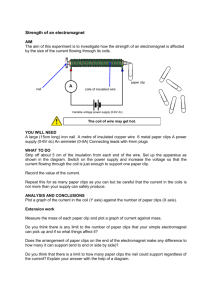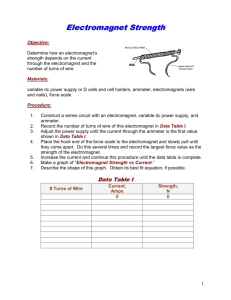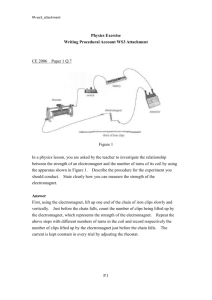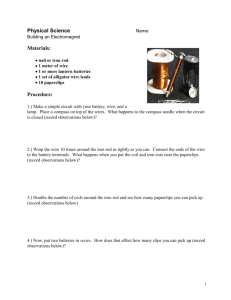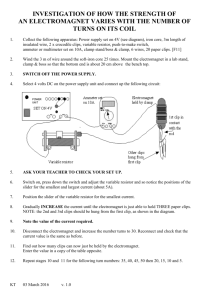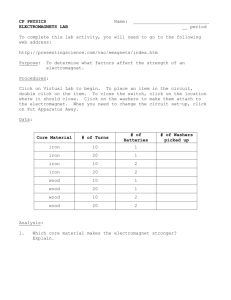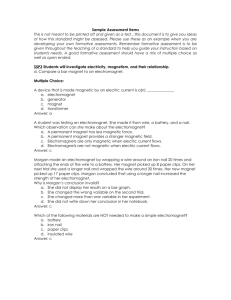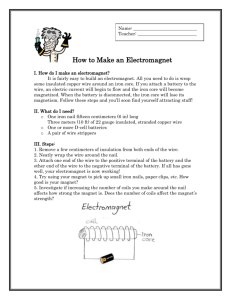Magnets And Electromagnets - Science Education at Jefferson Lab
advertisement
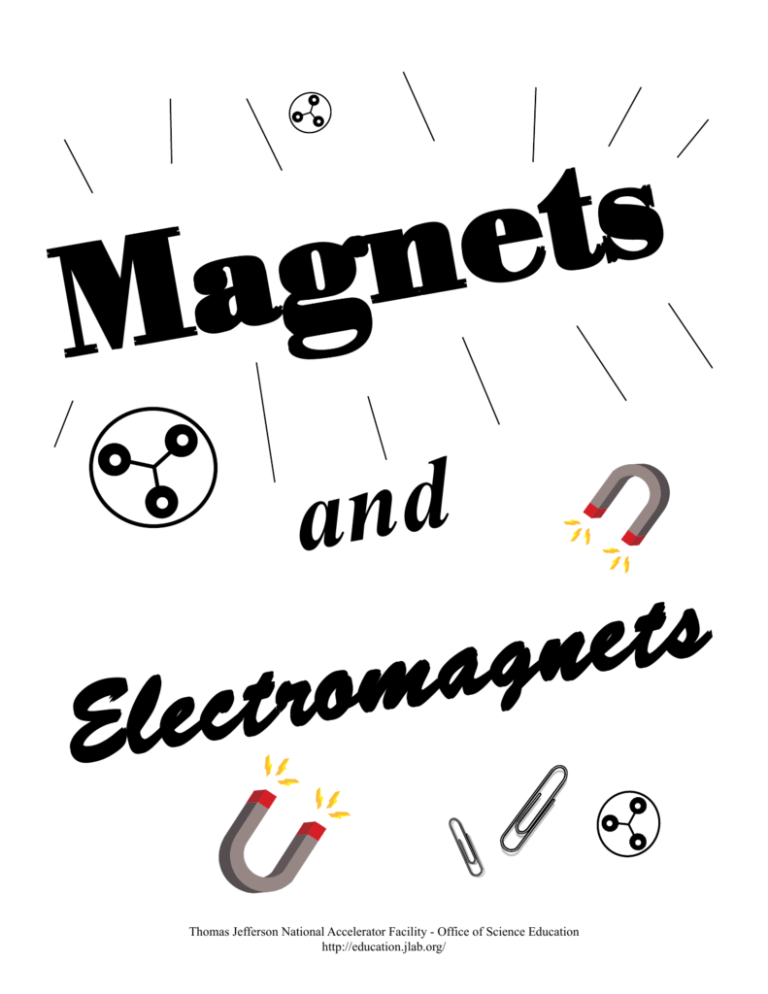
s t e n g a M and s t e n g a m o r t c e El Thomas Jefferson National Accelerator Facility - Office of Science Education http://education.jlab.org/ Magnets and Electromagnets Can you make a magnet from a nail, some batteries and some wire? Problems Can the strength of an electromagnet be changed by changing the voltage of the power source? Can the strength of an electromagnet be changed by changing the amount of wire wrapped around its core? Research Answer the following True or False questions about magnets and electromagnets: True/False Heating or hitting a permanent magnet can ruin it. True/False Iron is a good metal to use to make an electromagnet. True/False The north pole of one magnet will attract the north pole of another magnet. True/False Magnets and electromagnets are used in many devices. Hypotheses I think that increasing the voltage will the electromagnet’s strength. (increase, decrease or not change) I think that increasing the wire coils will the electromagnet’s strength. (increase, decrease or not change) Thomas Jefferson National Accelerator Facility - Office of Science Education http://education.jlab.org/ Procedure How to make the electromagnet: 1. To make an electromagnet, you will need: • A length of wire • A nail 2. Take the wire and straighten it. 3. One end of the wire has a clip attached. Hold the clip in your hand and measure off an arm’s length of wire. This splits the wire into two sections, one much longer than the other. 4. Take the long section of wire and wrap it neatly around the nail. Start wrapping at the flat part of the nail and work your way towards the nail’s point. 5. Wrap the wire around the nail 25 times to build the first electromagnet. Later, you will wrap the wire around the nail another 25 times to make a larger electromagnet. How to use the electromagnet: 1. To test your electromagnet you will need: • A battery pack • Some paper clips 2. There are four different settings on the battery pack. They are labeled 1.5V, 3.0V, 4.5V and 6.0V. The “V” stands for volts. A volt is a unit used to measure the amount of electricity in something, like meters is a unit used to measure the length of something. 3. Your team will test your electromagnet by seeing how many paper clips it can pick up at each voltage. Test each voltage two times. 4. There are two jobs to do: • Power Operator - turns the electromagnet on and off • Crane Operator - dunks the electromagnet into the container of paper clips 5. How do you turn the electromagnet on? Both ends of the wire have to be attached to the battery pack correctly so that electricity can flow: • Clip one end of the wire to the screw on the battery pack labeled TOP • Hold the other end of the wire onto the metal near the voltage label that you want to test REMEMBER: Metal has to touch metal for electricity to flow! Touch the wire to the metal screws, not to the plastic battery case! 6. Once the Power Operator has turned on the electromagnet, the Crane Operator should put the nail in the container of paper clips. Thomas Jefferson National Accelerator Facility - Office of Science Education http://education.jlab.org/ 7. Gently mix the paper clips with the electromagnet. 8. Carefully lift the electromagnet out of the paper clip container and move it to a clean spot over your desk. 9. Turn the electromagnet off by removing the wire from the battery pack and let the paper clips fall. 10. Count how many paper clips the electromagnet picked up and record that number on the Electromagnets Data Chart. 11. Keep testing your electromagnet until you have tried each voltage twice. 12. Once you have completely tested the electromagnet with 25 wraps of wire, build one with 50 wraps of wire and test it. 13. After you have finished testing the second electromagnet, make certain that everyone on your team has all of the data. 14. Average each voltage’s tests together. If you don’t remember how to average, look at the example below. 15. Use the Electromagnets Results Graph to show the average number of paper clips each electromagnet picked up at each voltage. How do I average 31, 22 and 43 together? Add up all the numbers that need to be averaged. Divide by the number of numbers you added. You added three numbers together, so you divide by three. If you had added two numbers together, you would have divided by two. If you had added 1000 numbers together, you would have divided by 1000. 31 22 + 43 96 32 3 96 - 996 6 06 -6 0 Thomas Jefferson National Accelerator Facility - Office of Science Education http://education.jlab.org/ Data Collection and Analysis Electromagnets Data Chart Directions: Record the number of paperclips picked up by each electromagnet for each try. After you have collected all of the data for both of the electromagnets, average the number of paper clips picked up at each voltage. For the 25-turn Electromagnet Battery Voltage Number of paper clips picked up First try Second try Average = st nd (1 + 2 ) 2 1.5V 3.0V 4.5V 6.0V For the 50-turn Electromagnet Battery Voltage 1.5V Number of paper clips picked up First try Second try Average = st nd (1 + 2 ) 2 3.0V 4.5V 6.0V Name that VARIABLE!! Directions: Identifiy the Independent Variables, Dependent Variable, Constants and Control of this experiment. Independent Variables Dependent Variable Constants Control Thomas Jefferson National Accelerator Facility - Office of Science Education http://education.jlab.org/ Let’s make a graph! Directions: Show the average number of paper clips each electromagnet picked up for each voltage tested. Use the averages you calculated on the Electromagnets Data Chart to make a line graph for each of the two electromagnets. Electromagnets Results Graph 70 KEY = 25-turn magnet 65 = 50-turn magnet 60 Average number of paper clips picked up 55 50 45 40 35 30 25 20 15 10 5 0 0 1.5 3.0 4.5 6.0 Battery Voltage Thomas Jefferson National Accelerator Facility - Office of Science Education http://education.jlab.org/ Conclusions IncreasIng the voltage applIed to an electromagnet Its strength. IncreasIng the amount of wIre wrapped around an electromagnet Its strength. QuestIons to thInk about 1. What happened to the strength of the electromagnet when more turns of wire were used? 2. What happened to the strength of the electromagnet when more volts were used? 3. How are electromagnets used at Jefferson Lab? 4. Where can you find electromagnets in your home? 5. How can you make a permanent magnet lose its magnetism? Thomas Jefferson National Accelerator Facility - Office of Science Education http://education.jlab.org/ Writing About Magnetism The electromagnets you made at Jefferson Lab attracted metal. Write about having a ‘magnetic touch.’ Think about what you know about magnets. As you are thinking, remember the story of King Midas (a king whose wish for everything he touched to become gold was granted). Use your imagination and decide what objects you would want to be attracted to you. What would the objects be made of? Would you be able to use the magnetic touch to solve problems? Could it create problems for you? Thomas Jefferson National Accelerator Facility - Office of Science Education http://education.jlab.org/ Averaging When you built electromagnets at Jefferson Lab you averaged the number of paper clips your magnet lifted. See if you can find the average, or mean, of some other numbers. Finding the mean. . . The average, or mean, of a group of numbers is found by adding all of the numbers together and then dividing that answer by how many numbers were added. For example, the average of 2, 4, 6 and 8 is found by adding 2, 4, 6, and 8 together (2 + 4 + 6 + 8 = 20) and then dividing that answer by 4 (since four numbers were added) to get 5 (20 ÷ 4 = 5). Find the mean of 78, 81, 82 and 79. Step 1: Find the sum of the numbers. Step 2: How many numbers were added? Step 3: Divide the sum by the number of numbers added. Your answer should be 80 80. Thomas Jefferson National Accelerator Facility - Office of Science Education http://education.jlab.org/ Directions: Find the mean. Show your work. 1. Sarah’s grades on her science quizzes were 85, 90, 60, 75 and 95. What was her average quiz grade? 2. The fifth grade had five students participate in a jump rope contest. Their number of jumps were 80, 50, 30, 65 and 45. What was their average number of jumps? 3. Courtney and her friends were experimenting with electromagnets. Courtney picked up 14 paper clips, Lou picked up 19, Sam picked up 21 and Amanda picked up 26. What was the average number of paper clips picked up? 4. Below are the ages of students in Miss Taylor’s class and the number of students at each age. Find the average age. Age Number of students at each age 10 4 11 7 12 4 13 1 5. A motorcycle went 865 km on 20 liters of gasoline. What is the average number of kilometers per liter? Thomas Jefferson National Accelerator Facility - Office of Science Education http://education.jlab.org/ Magnets and Electromagnets Can you make a magnet from a nail, some batteries and some wire? Problems Can the strength of an electromagnet be changed by changing the voltage of the power source? Can the strength of an electromagnet be changed by changing the amount of wire wrapped around its core? Research Answer the following True or False questions about magnets and electromagnets: True/False Heating or hitting a permanent magnet can ruin it. True/False Iron is a good metal to use to make an electromagnet. True/False The north pole of one magnet will attract the north pole of another magnet. True/False Magnets and electromagnets are used in many devices. Hypotheses I think that increasing the voltage will the electromagnet’s strength. (increase, decrease or not change) I think that increasing the wire coils will the electromagnet’s strength. (increase, decrease or not change) Thomas Jefferson National Accelerator Facility - Office of Science Education http://education.jlab.org/ Data Collection and Analysis Electromagnets Data Chart Directions: Record the number of paperclips picked up by each electromagnet for each try. After you have collected all of the data for both of the electromagnets, average the number of paper clips picked up at each voltage. For the 25-turn Electromagnet Battery Voltage 1.5V 3.0V 4.5V 6.0V Number of paper clips picked up First try Second try 5 12 14 20 7 12 17 26 Average = st nd (1 + 2 ) 2 6 12 15.5 23 For the 50-turn Electromagnet Battery Voltage 1.5V 3.0V 4.5V 6.0V Number of paper clips picked up First try Second try 10 28 30 44 16 24 32 50 Average = st nd (1 + 2 ) 2 13 26 31 47 Name that VARIABLE!! Directions: Identifiy the Independent Variables, Dependent Variable, Constants and Control of this experiment. Independent Variables Dependent Variable Constants Control battery voltage, turns of wire number of paper clips picked up length of wire, weight of clips, etc... bare nail Thomas Jefferson National Accelerator Facility - Office of Science Education http://education.jlab.org/ Let’s make a graph! Directions: Show the average number of paper clips each electromagnet picked up for each voltage tested. Use the averages you calculated on the Electromagnets Data Chart to make a line graph for each of the two electromagnets. Electromagnets Results Graph 70 KEY = 25-turn magnet 65 = 50-turn magnet 60 Average number of paper clips picked up 55 50 45 40 35 30 25 20 15 10 5 0 0 1.5 3.0 4.5 6.0 Battery Voltage Thomas Jefferson National Accelerator Facility - Office of Science Education http://education.jlab.org/ Conclusions IncreasIng the voltage applIed to an electromagnet Its strength. IncreasIng the amount of wIre wrapped around an electromagnet Its strength. QuestIons to thInk about 1. What happened to the strength of the electromagnet when more turns of wire were used? The greater the number of turns of wire, the stronger the electromagnet is. 2. What happened to the strength of the electromagnet when more volts were used? Increasing the voltage increases the amount of electricity that flows through the wire which increases the strength of the electromagnet. 3. How are electromagnets used at Jefferson Lab? They steer the beam around the arcs and keep the beam focused. 4. Where can you find electromagnets in your home? Answers will vary. Computers, telephone, items with electric motors, etc... 5. How can you make a permanent magnet lose its magnetism? By heating, melting or hitting them. Thomas Jefferson National Accelerator Facility - Office of Science Education http://education.jlab.org/ Directions: Find the mean. Show your work. 1. Sarah’s grades on her science quizzes were 85, 90, 60, 75 and 95. What was her average quiz grade? 85 + 90 + 60 + 75 + 95 = 405 405 ÷ 5 = 81 2. The fifth grade had five students participate in a jump rope contest. Their number of jumps were 80, 50, 30, 65 and 45. What was their average number of jumps? 80 + 50 + 30 + 65 + 45 = 270 207 ÷ 5 = 54 3. Courtney and her friends were experimenting with electromagnets. Courtney picked up 14 paper clips, Lou picked up 19, Sam picked up 21 and Amanda picked up 26. What was the average number of paper clips picked up? 14 + 19 + 21 + 26 = 80 80 ÷ 4 = 20 4. Below are the ages of students in Miss Taylor’s class and the number of students at each age. Find the average age. Age Number of students at each age 10 4 11 7 12 4 13 1 (10 * 4) + (11 * 7) + (12 * 4) + (13 * 1) = 178 178 ÷ 16 = 11.125 5. A motorcycle went 865 km on 20 liters of gasoline. What is the average number of kilometers per liter? 865 km ÷ 20 l = 43.25 km/l Thomas Jefferson National Accelerator Facility - Office of Science Education http://education.jlab.org/ Magnets and Electromagnets This is an activity in which students construct and test the strengths of two electromagnets. Objectives: In this activity students will: • work in teams • build an electromagnet with 25 turns of wire • test the 25-turn electromagnet’s strength at 4 different voltages by using it to pick up paperclips • build an electromagnet with 50 turns of wire • test the 50-turn electromagnet’s strength at 4 different voltages by using it to pick up paperclips • record data • calculate the average number of paperclips each electromagnet lifted at each voltage • create a line graph to depict each electromagnet’s strength Questions to Ask: 1. Does it matter what direction you wind the wire? 2. How can you tell which end of the electromagnet is north and which is south? 3. Where are some places you can find electromagnets at home? Travel Book Activities: • Writing About Magnetism • Averaging Thomas Jefferson National Accelerator Facility - Office of Science Education http://education.jlab.org/ Virginia State Standards of Learning Math 6.2 Number and Number Sense • by comparing the strength of an electromagnet using varying currents and coils of wire Math 6.18 Probability and Statistics • by collecting, analyzing, displaying, and interpreting data about electromagnets of varying strengths as they relate to the voltage applied to them Science 6.1 Plan and Conduct Investigations • by identifying differences in descriptions and the construction of working definitions • by recording precise and approximate measurements • by stating hypotheses in a way that identifies the independent and dependent variables • by devising methods to test the validity of predictions and inferences • by manipulating one variable over time with repeated trials • by collecting, recording and analyzing data using appropriate metric measures • by organizing and communicating data through graphical representations Science 6.2 Demonstrate Scientific Reasoning and Logic • by performing multiple tests of ideas before accepting or rejecting them Science 6.4 Force, Motion and Energy • by investigating and understanding the relationship between electricity and magnetism • by learning that electrical energy can be described in volts LS.1 Plan and Conduct Investigations • by organizing data into tables showing repeated trials and means • by defining variables • by using SI (metric) units • by establishing criteria for evaluating a prediction • by identifying sources of experimental error • by identifying independent variables, dependent variables and constants • by controlling variables with repeated trials to test the hypotheses • by constructing, interpreting and using continuous line graphs to make predictions • by evaluating and defending interpretations from the same set of data PS.1 Plan and Conduct Investigations • by recording and interpreting data from line graphs • by identifying independent and dependent variables, constants, controls and repeated trials • by making valid conclusions after analyzing data PS.11 Investigate and Understand Basic Principles of Electricity and Magnetism • by understanding the concepts of current and circuits • by understanding magnetic fields and electromagnets Thomas Jefferson National Accelerator Facility - Office of Science Education http://education.jlab.org/ Magnets and Electromagnets Teacher Overview and Materials List Background: Electromagnets are a part of our everyday lives. They are useful because they act like magnets when the current is on and lose their magnetism when the current is off. Some electromagnets we use everyday are in school bells, telephones, automatic doors and tape recorders. Scientists at Jefferson Lab use electromagnets to focus and steer the electron beam around the accelerator and to help guide and measure the charged particles resulting from their experiments. Minimum Materials Needed for Each Student Group: A large iron nail ~16 centimeters (~6 inches) long 3 meters (~10 feet) of No. 22 insulated, stranded copper wire Four 1.5 volt batteries (D cells) A battery holder to hold the four batteries 100 metal paper clips A small container to hold the paper clips Optional Materials: Alligator clips A soldering iron and solder Small screws and nuts Voltage labels Thick, strong tape Pre-Activity Preparations: The Wire 1. Strip a few centimeters of insulation off of each end of the wire. 2. Attach an alligator clip to one end of the wire. 3. Bend the exposed wire on the remaining end of the wire into a "U" shape. Twist the wire together and apply some solder to keep the wire from unraveling. The Battery Holder We modified our battery holder to make it easier to apply different voltages.If your battery holder is of a different type, these modifications may not be possible. 1. Remove all wires that came attached to the battery holder. 2. There is a hole at the positive end of the battery holder. Take a small screw and place it through this hole so that the screw's head is inside the battery pack. Secure the screw in place with a nut. Make certain that the nut does not completely cover the screw since the alligator clip will be attached here. 3. There are other holes in the battery pack that correspond to the negative terminals of each battery. Place small screws in each of these holes so that the screw's heads are on the outside the battery pack. Secure the screws in place with nuts. The screws should be as short as possible so that they don't unnecessarily interfere with the placement of the batteries. 4. Label the screws so that the students will be able to tell what voltage the electromagnet is using. The Nail 1. Wrap some tape around the point of the nail to prevent the students from making creative designs on the table tops. Thomas Jefferson National Accelerator Facility - Office of Science Education http://education.jlab.org/ Materials for Magnets and Electromagnets Thomas Jefferson National Accelerator Facility - Office of Science Education http://education.jlab.org/

